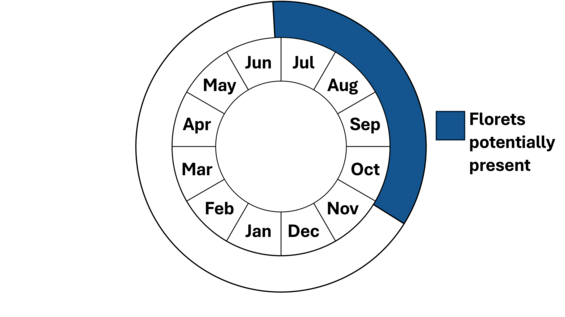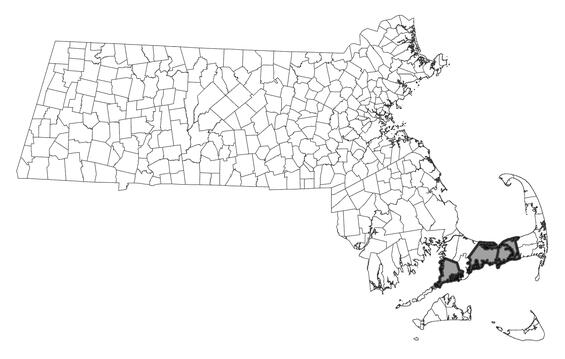- Scientific name: Dichanthelium wrightianum (Scribn.) Freckmann
- Species of Greatest Conservation Need (MA State Wildlife Action Plan)
- Special Concern (MA Endangered Species Act)
Description
Dichanthelium wrightianum inflorescence. Phtoto by Bruce A. Sorrie.
Wright’s rosette-grass, Dichanthelium wrightianum is a small, perennial grass (family Poaceae) of coastal plain pond shores in Massachusetts. One to several erect culms (stems) 15-50 cm (6–19.5 in) tall arise from a basal rosette of short, ovate-lanceolate leaves which differ morphologically from the ascending to spreading narrowly lanceolate stem leaves. Dichanthelium means twice flowering, referring to a vernal (early season) phase with panicles (branched inflorescence) from upright stems and an autumnal (late season) phase with more profuse branching on sometimes decumbent (lying on the ground) stems. Like many other coastal plain pond associates, this species may be dormant during periods of high water, and seeds may persist in the seed bank; then, in years where the water levels drop sufficiently to expose the shoreline habitat, Wright’s rosette-grass may appear in abundance.
Mature panicles with spikelets are necessary for identification. Wright’s rosette-grass has panicles 2.5-5.5 cm (1-2 in) long, with a width that is 1/3-2/3 the length. The minute spikelets, which include two glumes (lower bracts) at the base of a single floret (lemma and palea), are 0.8-1.1 mm (~0.04 in) long. These can be puberulent (having minute, soft hairs) to subglabrous (almost without hairs) and may be purplish in color. The cauline (stem) leaves are 2-4.5 cm (0.75-1.75 in) by 2-5 mm (0.08-0.2 in), puberulent on the underside, and with finely appressed hairs on the upper side. The ligule is hairy, 1.5-3 mm (0.06-0.12 in). The nodes are slightly swollen and can be dark green or purplish.
Wright’s rosette-grass habitats often have several congeners and other similar grasses growing in them. The most outstanding differentiating character of the Wright’s rosette-grass is its very small spikelets; also, it tends to be smaller overall than any other grass species found growing with it.
The most common similar species found are the following: woolly rosette-grass (Dichanthelium lanuginosum), tangled rosette-grass (D. implicatum), smooth rosette-grass (D. spretum), warty rosette-grass (Panicum verrucosum), and northern muhly (Muhlenbergia uniflora). See the chart below for differentiating characters.
Florets. Photo by C. Roberta Lombardi
Life cycle and behavior
Wright’s rosette-grass is a perennial species that will grow and fruit when the water levels drop low enough to expose the dormant plants and the seed bank. In drought years, this may occur as early as July, and in years when low water occurs in late summer, this may occur into October; however, most observations of fruiting plants are made in August and September. Vernal stems can potentially be observed from June through September, and autumnal forms from July into November.
| Species | Spikelet size | Leaf and sheath |
|---|---|---|
| Wright’s rosette-grass | 0.8–1.1 mm | puberulent (no papillose hairs) |
| Fascicled rosette-grass | 1.5–2 mm | papillose hairs |
| Tangled rosette-grass | 1.1–1.6 mm | papillose hairs |
| Smooth rosette-grass | 1.3–1.9 mm | glabrous |
| Warty rosette-grass | 1.6–2 mm, warty | glabrous |
| Northern muhly | 1.3– 2.1 mm, purplish, sometimes 2 florets | short, hairy above, glabrous to slightly scabrous beneath |
Research into the pollination of rosette-grasses has shown that this genus relies heavily on self-pollination through cleistogamous flowers (ones that do not open). A study of the related species D. clandestinum demonstrated that the cleistogamous flowers produce ten times more seed than the open flowers fertilized by wind pollination (chasmogamous). However, the seeds produced through wind cross-pollination had greater dormancy (Bell and Quinn 1985). There is no known mechanism for seed distribution in this species. Some seed may be washed by waves from the coastal plain pond water to new locations, but most seed likely fall and stays near the parent plants.

Population status
Wright’s rosette-grass is listed under the Massachusetts Endangered Species Act as Special Concern. All listed species are protected from killing, collecting, possessing, or sale, and from activities that would destroy habitat and thus directly or indirectly cause mortality or disrupt critical behaviors. Wright’s rosette-grass has been observed at 18 coastal plain ponds in Barnstable and Plymouth Counties since 1999. An additional 19 populations, also all within Barnstable and Plymouth Counties, have not been observed recently.

Distribution in Massachusetts
1999-2024
Based on records in the Natural Heritage Database
Distribution and abundance
This species is known from Massachusetts south along the Atlantic coastal plain to Florida, and south to Cuba, and is considered rare in many states. It is at the northernmost part of its range in Massachusetts. In New England, it only occurs in Massachusetts and Rhode Island. It has not been found in Connecticut.
Habitat
In Massachusetts, Wright’s rosette-grass inhabits moist, acidic, peaty to sandy, coastal plain pond shores, often in low, dense herbaceous vegetation. Coastal plain ponds typically have no inlet or outlet and are fed by groundwater and precipitation; they are characterized by pronounced water level fluctuations, acidic, nutrient-poor water and substrate, and (in periods of draw-down), an open, exposed shoreline populated primarily by herbaceous plants. Associated plant species include several other species of conservation concern that are restricted in Massachusetts to coastal plain ponds; for example, Plymouth gentian (Sabatia kennedyana; Special Concern), pink tickseed (Coreopsis rosea; Watch List), black-fruited spike-sedge (Eleocharis melanocarpa; Watch List), annual umbrella-sedge (Fuirena pumila; Watch List), and hyssop hedge-nettle (Stachys hyssopifolia; Watch List). Other, more common associated species include thread-leaf sundew (Drosera filiformis), round-leaved sundew (D. rotundifolia), large cranberry (Vaccinium macrocarpon), and Sphagnum spp. Interestingly, it is often found in limestone rich areas in the southern US (Weakley 2020).
Healthy habitats are vital for supporting native wildlife and plants. Explore habitats and learn about conservation and restoration in Massachusetts.
Phtoto by Bruce A. Sorrie.
Threats
Preservation of Wright’s rosette-grass requires protection of the natural hydrology, water quality, and soil integrity of its coastal plain pond habitat. Like other coastal plain pond shore species, it requires pronounced water-level fluctuations and acidic, nutrient-poor water, and a substrate free from major soil disturbance. Threats include excessive or continual water table drawdown from municipal wells, eutrophication resulting from nutrient inputs from septic systems, pet waste, and lawns, and trampling and soil disturbance due to recreational use of pond shores (i.e., ATVs, hiking, sunbathing, swimming, fishing, boat-launching, raking and digging). Protection of Wright’s rosette-grass may require exclusion of new wells and septic systems, prohibitions on fertilizer use, and restrictions on recreational use of the pond shores. Recreational activities should be diverted from rare plant population locations by providing alternative locations for these activities.
Also, habitats should be monitored for exotic plant species invasions. The nature of coastal plain ponds makes them generally inhospitable to many exotic plants. However, they can become established at sites that have soil disturbance or heavy nutrient inputs. Exotic species that are known from the shoreline of coastal plain ponds include common reed (Phragmites australis ssp. australis), gray willow (Salix cinerea), and purple loosestrife (Lythrum salicaria).
Conservation
Survey and monitoring
Surveys for Wright’s rosette-grass are needed on a regular basis during “low water years,” which are years when the climate is slightly drier than normal and the water levels within the coastal plain ponds drop to expose a sandy shoreline. The best time to survey for this species is during August and September though it may be found, depending on the conditions during the summer, from July through November. Appropriate habitat in which Wright’s rosette-grass is undocumented should be searched, especially in low-water years.
Management
Many coastal plain ponds have seen an increase in invasive plant species present on the shorelines. Wright’s rosette-grass is a short species and is easily over-topped and out-competed through shading by more aggressive species. It is recommended that an assessment of invasive plants on a pond shore be completed and if needed that a plan be made to remove any invasive plants. All active management of rare plant populations (including invasive species removal) is subject to review under the Massachusetts Endangered Species Act and should be planned in close consultation with MassWildlife’s Natural Heritage & Endangered Species Program.
Research needs
The conservation of this species would benefit from further study of the methods of seed dispersal and colonization of ponds. In addition, studies into the length of time seeds of this species can remain viable would be helpful to determine the species viability when it hasn’t been observed in several years due to high water conditions.
References
Bell, Timothy J. and James A Quinn. 1985. Relative Importance of Chasmogamously and Cleistogamously Derived Seeds o Dichanthelium clandestinum (L.) Gould. Botanical Gazette, 146:2, June. Pp. 252-258.
Fernald, M. L. 1950. Gray’s Manual of Botany, Eighth (Centennial) Edition—Illustrated. American Book Company, New York.
Freckman, R.W. and M.G. Lelong. Dichanthelium ovale. Flora of North America: North of Mexico, volume 25: Magnoliophyta: Commelinidae (in part): Poaceae, Part 2. Oxford University Press, 2003. Pg 430.
Gleason, Henry A., and Arthur Cronquist. Manual of Vascular Plants of Northeastern United States
and Adjacent Canada, Second Edition. Bronx, NY: The New York Botanical Garden, 1991.
Haines, Arthur. Flora Novae Angliae. New England Wild Flower Society, Yale University Press, New Haven, CT. 2011.
Magee, Dennis W. Grasses of the Northeast. University of Massachusetts Press, Amherst, Massachusetts. 2014.
Native Plant Trust. 2014. NORM Phenology Information.
NatureServe. 2025. NatureServe Network Biodiversity Location Data accessed through NatureServe Explorer [web application]. NatureServe, Arlington, Virginia. Available https://explorer.natureserve.org/. Accessed: 3/12/2025.
POWO (2025). "Plants of the World Online. Facilitated by the Royal Botanic Gardens, Kew. Published on the Internet; https://powo.science.kew.org/ Retrieved 3/12/2025."
Weakley, A.S. 2020. Flora of the southeastern United States. University of North Carolina Herbarium, North Carolina Botanical Garden, Chapel Hill, NC.
Contact
| Date published: | April 14, 2025 |
|---|